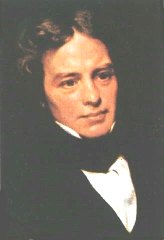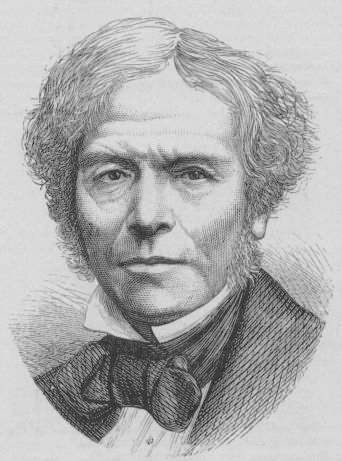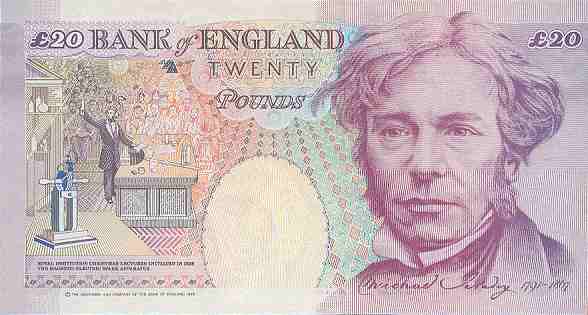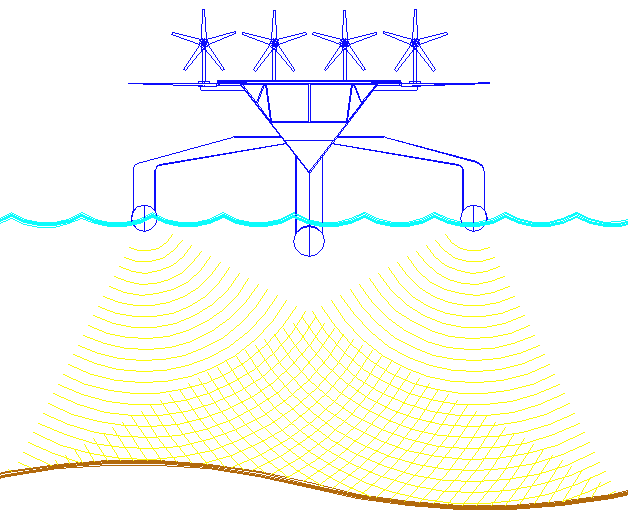|
MICHAEL FARADAY
|
|||
|
Michael Faraday, FRS (September 22, 1791 – August 25, 1867) was a British chemist and physicist (who considered himself a natural philosopher) who contributed significantly to the fields of electromagnetism and electrochemistry. He also invented the earliest form of the device that was to become the Bunsen burner, which is used almost universally in science laboratories as a convenient source of heat.
Michael Faraday
Some historians of science refer to him as the greatest experimentalist in the history of science. It was largely due to his efforts that electricity became viable for use in technology. The SI unit of capacitance, the farad, is named after him, as is the Faraday constant, the charge on a mole of electrons (about 96,485 coulombs). Faraday's Law of induction states that a magnetic field changing in time creates a proportional electromotive force.
He held the post of Fullerian Professor of Chemistry at the Royal Institution of Great Britain.
Early career
Michael Faraday was born in Newington Butts, near present-day Elephant and Castle in south London. His family was poor, his father, James Faraday, was a blacksmith who suffered ill-health throughout his life. As such, Faraday had to educate himself. At fourteen he became apprenticed to bookbinder and seller George Riebau and, during his seven year apprenticeship, read many books, developing an interest in science and specifically electricity. In particular, he enjoyed the book Conversations in Chemistry by Jane Marcet, which inspired him.
At the age of twenty, in 1812, at the end of his apprenticeship, Faraday attended lectures by the eminent English (Cornish) chemist and physicist Humphry Davy of the Royal Institution and Royal Society, and John Tatum, founder of the City Philosophical Society. The tickets were given Faraday by William Dance (one of founders of the Royal Philharmonic Society). After, Faraday sent Davy a sample of notes taken during the lectures, Davy said he would keep Faraday in mind but he should stick to his current job of book-binding. After Davy damaged his eyesight in an accident with nitrogen trichloride, he employed Faraday as a secretary. When John Payne of the Royal Institution was fired, the now Sir Humphry Davy was asked to find a replacement for him, so that Faraday was appointed Chemical Assistant at the Royal Institution on 1 March 1813.
Faraday eagerly left his bookbinding job and his hot-tempered employer, Henry de la Roche.
In a class-based society, Faraday was not considered a gentleman. When Davy went on a long tour to the continent in 1813-5, his valet refused to go. Faraday was part of the party as Davy's scientific assistant, and was asked to act as Davy's valet until a replacement could be found in Paris. Davy failed to find a replacement, and Faraday was forced to fill the role of valet as well as assistant throughout the trip. Davy's wife, Jane Apreece, refused to treat Faraday as an equal (making him travel outside the coach, eat with the servants, etc.) and generally made Faraday so miserable he contemplated returning to England alone and giving up science altogether. However, it was not long before Faraday surpassed Davy.
He also was the first to link electricity to magnetism and then link magnetism back to electricity - i.e. he induced an electric current using magnets - thus inventing the dynamo, predecessor to today's electric generator.
Scientific career
His greatest work was with electricity. In 1821, soon after the Danish physicist and chemist, Hans Christian Ørsted discovered the phenomenon of electromagnetism, Davy and British scientist William Hyde Wollaston tried but failed to design an electric motor. Faraday, having discussed the problem with the two men, went on to build two devices to produce what he called electromagnetic rotation: a continuous circular motion from the circular magnetic force around a wire. A wire extending into a pool of mercury with a magnet placed inside would rotate around the magnet if supplied with current from a chemical battery. This device is known as a homopolar motor. These experiments and inventions form the foundation of modern electromagnetic technology. Unwisely, Faraday published his results without acknowledging his debt to Wollaston and Davy, and the resulting controversy caused Faraday to withdraw from electromagnetic research for several years.
At this stage, there is also evidence to suggest that Davy may have been trying to slow Faraday’s rise as a scientist (or natural philosopher as it was known then). In 1825, for instance, Davy set him onto optical glass experiments, which progressed for six years with no great results. It was not until Davy's death, in 1829, that Faraday stopped these fruitless tasks and moved on to endeavors that were more worthwhile.
Two years later, in 1831, he began his great series of experiments in which he discovered electromagnetic induction, though the discovery may have been anticipated by the work of Francesco Zantedeschi. He found that if he moved a magnet through a loop of wire, an electric current flowed in the wire. The current also flowed if the loop was moved over a stationary magnet.
His demonstrations established that a changing magnetic field produces an electric field. This relation was mathematically modelled by Faraday's law, which subsequently became one of the four Maxwell equations. These in turn evolved into the generalization known as field theory.
Faraday then used the principle to construct the electric dynamo, the ancestor of modern power generators.
Faraday proposed that electromagnetic forces extended into the empty space around the conductor, but did not complete his work involving that proposal. Faraday's concept of lines of flux emanating from charged bodies and magnets provided a way to visualize electric and magnetic fields. That mental model was crucial to the successful development of electromechanical devices which dominated engineering and industry for the remainder of the 19th century.
Faraday worked extensively in the field of chemistry, discovering chemical substances such as benzene, inventing the system of oxidation numbers, and liquefying gases such as chlorine. He prepared the first clathrate hydrate. Faraday also discovered the laws of electrolysis and popularized terminology such as anode, cathode, electrode, and ion, terms largely created by William Whewell. For these accomplishments, many modern chemists regard Faraday as one of the finest experimental scientists in history. Despite his excellence as an experimentalist, his mathematical ability did not extend so far as trigonometry or any but the simplest algebra.
In 1845 he discovered what is now called the Faraday effect and the phenomenon that he named diamagnetism. The plane of polarization of linearly polarized light propagated through a material medium can be rotated by the application of an external magnetic field aligned in the propagation direction. He wrote in his notebook, "I have at last succeeded in illuminating a magnetic curve or line of force and in magnetising a ray of light". This established that magnetic force and light were related.
In his work on static electricity, Faraday demonstrated that the charge only resided on the exterior of a charged conductor, and exterior charge had no influence on anything enclosed within a conductor. This is because the exterior charges redistribute such that the interior fields due to them cancel. This shielding effect is used in what is now known as a Faraday cage.
Later life
More that a half a century after a teenaged Faraday first visited the Royal Institution, he could still be found there, spending hours watching the sky from his window.
"Next Sabbath day (the 22nd) I shall complete my 70th year. I can hardly think of myself so old." — Faraday
During his lifetime, Faraday rejected a knighthood and twice refused to become President of the Royal Society.
He died at his house at Hampton Court on August 25, 1867. He is buried in Westminster Abbey, near Isaac Newton's tomb.
Miscellaneous
He gave a successful series of lectures on the chemistry and physics of flames at the Royal Institution, entitled The Chemical History of a Candle; this was the origin of the Christmas lectures for young people that are still given there every year and bear his name.
Faraday was known for designing ingenious experiments, but lacked a good mathematics education. (However, his affiliation with James Clerk Maxwell helped in this regard, as Maxwell was able to translate Faraday's experiments into mathematical language.) He was regarded as handsome and modest, declining a knighthood and presidency of the Royal Society (Davy's old position).
Michael Faraday on a British £20 banknote
His picture was printed on British £20 banknotes from 1991 until 2001. Faraday was the first, and most famous, holder of this position to which he was appointed for life.
His sponsor and mentor was John 'Mad Jack' Fuller, who created the Fullerian Professorship of Chemistry at the Royal Institution.
Faraday was also a devout Christian and a member of the small Sandemanian denomination, an offshoot of the Church of Scotland. He served two terms as an elder in the group's church.
Faraday married Sarah Barnard in 1821 but they had no children. They met through attending the Sandemanian church.
Publications
References
Kessenger Publishing, Whitefish, MT. ISBN 1417970367 Quotations
LINKS:
Biographies
Others
INVENTORS A - Z
The ultimate Robot Boat. Solarnavigator uses an advanced SWASSH hull as the platform to mount the world's first autonomous circumnavigation. A successful expedition could pave the way for improved safety at sea.
|
|||
|
This website is copyright © 1991- 2013 Electrick Publications. All rights reserved. The bird logo and names Solar Navigator and Blueplanet Ecostar are trademarks ™. The Blueplanet vehicle configuration is registered ®. All other trademarks hereby acknowledged and please note that this project should not be confused with the Australian: 'World Solar Challenge'™which is a superb road vehicle endurance race from Darwin to Adelaide. Max Energy Limited is an educational charity working hard to promote world peace.
|
|||
|
AUTOMOTIVE | BLUEPLANET BE3 | ELECTRIC CARS | ELECTRIC CYCLES | SOLAR CARS | SOLARNAVIGATOR |



